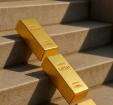Wall Street bets on gold consolidation or correction, Main Street remains bullish as Fed rate decision and major data loom
NEW YORK (July 26) Gold was a story of two halves this week, with near mirror-image performances splitting the weekly price chart around Tuesday evening.
Spot gold kicked off the week trading at $3,347.05, and there was no stopping the yellow metal in the early going. Gold prices rallied to $3,370 during the Asian and European sessions and shot all the way up to the edge of $3,390 ahead of the North American open on Monday morning. By 11:00 a.m. EDT, spot gold had established a near-term top right at the $3,400-per-ounce resistance level.
After a second attempt to breach $3,400 failed just after 7:00 p.m. Eastern, gold dipped back down to the mid-3,380s, but the European session brought renewed momentum to the yellow metal, and by Tuesday's North American open, spot gold was trading comfortably above $3,400, ultimately topping out near $3,433 per ounce.
But this is where gold prices encountered real resistance, as a half-dozen attempts to break through failed, and on Wednesday morning, gold fell back down to near-term support at $3,383 per ounce.
Following a day of uneventful sideways trading within a $10 range, gold prices turned pumpkin at the stroke of midnight, with the yellow metal embarking on a steady downward slide all the way to $3,353 by 8:45 a.m. EDT Thursday morning.
Gold made one final attempt to challenge near-term resistance in the low 3380s, but quickly ran out of steam, and overnight trading drove the yellow metal down to $3,340 by Friday’s North American open.
After a quick drop down to set the weekly low at $3,327 per ounce, gold bounced back up to the edge of $3,340, where it traded into the weekend.

The latest Kitco News Weekly Gold Survey showed industry experts now divided between bears and fence-sitters, while retail traders maintained their renewed bullish bias on gold’s near-term prospects.
“Sideways,” said Darin Newsom, senior market analyst at Barchart.com. “Why? There is no reason to believe gold is going to collapse at this point, though it could drift lower as buying interest shifts to silver and copper. But the underlying reason for gold’s strength - a safe haven against global ‘certain uncertainty’ - has not changed. There’s no telling what will be said next.”
“It’s interesting to hear rumblings that China may have been buying more gold than previously thought,” Newsom added. “I don’t see these supplies being dumped on the market any time soon.”
Analysts at Commerzbank said that gold appears to be looking for direction as potential trade agreements are impacting the precious metal's safe-haven allure. They are neutral in the near term as they believe prices have peaked for now.
“Higher,” said Rich Checkan, president and COO of Asset Strategies International. “The sell-off today sets the stage for a gain next week. If the FOMC acts as expected and leaves rates alone, gold and silver continue climbing higher. If the Fed surprises and cuts rates, gold and silver surge higher. Either way… higher.”
“Cautious, as the Dollar may be putting in a bottom,” warned Mark Leibovit, publisher of the VR Metals/Resource Letter.
“Up,” said James Stanley, senior market strategist at Forex.com. “I think we’re seeing a pullback, and while I’m not expecting the Fed to sound uber-dovish, they also don’t have to step on rate cut expectations for the rest of the year, instead opting to see more data.”
“I think that’ll show as a bullish reaction in gold, much as we’ve seen over the past year and a half,” Stanley predicted.
“Unchanged,” said Adrian Day, president of Adrian Day Asset Management. “Gold will likely continue trading within a reasonably narrow range, as is has since mid-April, awaiting meaningful developments that could allow it to break out, one way or the other. A series of major trade deals and reasonably positive economic news will give investors reason to hold off. Also, the dollar is overdue for a rally. But there are certainly buyers in the wings, ready to take it higher if circumstances change.”
Kevin Grady, president of Phoenix Futures and Options, said the good news is weighing on precious metals prices.
“I think positive news coming out on the trade tariffs, it’s just putting a little pressure on gold,” he said. “That being said, even though it looks like the deals are coming through, whether it's Japan, the EU, Britain, India, it seems like gold takes a little dip and then it tends to rally right back up.”
“I think, especially on a Friday with very thin markets, I think the algorithms are trading the news,” Grady said. “I think the algos are trading the news, and I think they just say, ‘Okay, equities are being positive, the metals should dip.’”
He doesn’t think this will be enough to drive a real correction in gold prices. “It’ll pull back a little, but I don't think you're going to be seeing $2,700.”
Looking ahead to next week, Grady said that whether it’s the language of the Fed statement, PCE inflation, or nonfarm payrolls, traders will be focused on what it means for the September meeting.
“I think it's all about the rates,” he said. “I've been saying that for a while. And again, when energy prices were still up, I didn't think it was prudent to cut rates. Obviously, [Trump] wants to lower, I understood that, but I didn't think it was prudent. But now everything I see, when you're looking at PCE, jobless claims, everything to me says he should be cutting rates. But I don't think he's going to do it.”
“I think the verbiage coming out of the meeting is going to be interesting,” Grady added. “I think there’s going to be dissension, because if you think about it, why are you waiting? ‘You told us what you were waiting for, you were worried about inflation, you were worried about energy prices, you were worried about the big, beautiful bill. You were worried about tariffs causing massive inflation. None of that's happened.’”
Grady agreed that Powell should, at the very least, signal that the FOMC is adopting a dovish stance. “I think he should, because that's the situation,” he said.
But even if Powell adopts a dovish tone and equities take off, that doesn’t mean gold can’t rally as well.
“It's one of those odd trades,” Grady said. “I think we're in a very weird situation, because gold is not rallying because people are afraid of what's going on with the markets. I think you'd have a situation – which we've seen over the last two years – of equities rallying and gold rallying.”
“I think the central banks buying gold are not going to stop,” he said. “ I think they know what they want to do. I think a lot of people want to diverge from the US dollar, and I think that's going to continue, so I think you'll see a lot of people still buying gold.”
“All you have to do is look at a chart and you see what happened, you see both of them rallying in tandem,” he said. “Gold will rally with equities. They rally for their own reasons.”
This week, 14 analysts participated in the Kitco News Gold Survey, with Wall Street bulls in short supply after gold’s failed breakout. Only two experts, or 14%, still expect to see gold prices rise during the week ahead, while five others, representing 36%, predicted a price decline. The remaining seven analysts, or 50%, saw the yellow metal’s price trading in a sideways range next week.
Meanwhile, 206 votes were cast in Kitco’s online poll, with Main Street investors retaining their bullish majority opinion. 135 retail traders, or 66%, looked for gold prices to rise next week, while 40, or 19%, expected the yellow metal to post a decline. The remaining 31 investors, or 15%, saw prices continuing to consolidate during the week ahead.

Next week’s economic news docket is bursting at the seams, with reams of growth, inflation, and employment data to keep traders on their toes, as well as three major interest rate decisions.
On Tuesday, markets will pay attention to JOLTS job openings and U.S. Consumer Confidence for July. Then on Wednesday, traders will receive ADP employment data, U.S. advance GDP for Q2, and pending home sales.
The day will also be punctuated by the monetary policy decisions of the Bank of Canada, the Federal Reserve, and the Bank of Japan.
Thursday brings the latest PCE inflation data for July along with weekly jobless claims, and the week wraps up with July’s nonfarm payrolls and the ISM Manufacturing PMI on Friday.
“Gold still looks heavy,” said Marc Chandler, managing director at Bannockburn Global Forex. “It is finishing the week with new lows for the week, so far slightly below $3337 in the spot market. It stalled in the middle of the week near $3439, shy of the June high ($3451). It is flirting with this month’s uptrend, which comes in $3339.50. A break of $3321.50 would target $3309 next, and a push below $3300 could spur a move toward $3250.”
“Next week is one of the busiest of the year, with US GDP, FOMC meeting, PCE deflator, employment and the ostensible end of the postponement of US reciprocal tariffs,” he noted. “The eurozone report Q2 GDP too and the preliminary estimate of July CPI. The Bank of Canada and the Bank of Japan meet. Both are expected to stand pat.”
Daniel Pavilonis, senior commodities broker at RJO Futures, conceded that gold is dipping due to the positive trade deal news.
“But more importantly for gold, it's just been a sideways market for several months now,” he said. “We're still rangebound. We got up to the upper end of the range, and now we're backing off, maybe we get back down to the lower end of the range, but it's been a sideways market since April when we made that high of $3,509. There just hasn't been anything to really drive the price higher.”
“Maybe some of this could be anticipation of trade deals,” he suggested. “We don't really know for certain what they're going to look like, or if August 1st gets kicked further down the road, just like July 9th did. If gold stays sideways, maybe long-term it's starting to build support here, and maybe we continue to move higher, but there hasn't been a major theme to really move the needle on this.”
“We've seen this whipsaw several times since April,” he added. “It's just really a no man's land here. We've made consecutively lower highs, but we're consecutively making higher lows. We're just building into a pennant. I think if we start to break lower, the 50-day moving average is somewhere right around here. We could start to come back down to the 100-day, which is $3,227, $3,232, somewhere around that area. And then maybe below that we touch that 200-day moving average at about $3,000.”
“But I don't think anything's really changed on the trading side of the markets,” Pavilonis said. “Everybody wants to be long the metals. The gold investors are pretty built into the price of gold right now, and I don't think they're getting out. I don't think there's any reason to rush for the exits. I think it's just more consolidation.”
Pavilonis said the biggest question on the trade front is what all of this means for inflation. “A big part of gold's move was because of inflation, that tariffs were going to cause major inflation,” he said. “We really haven't seen inflation. Yields seem like they're backing off a little bit, 10-year yields are backing off."
“If the Fed comes in and starts cutting rates prematurely, maybe after a few quarters we start to see inflation tick up again, that could be problematic,” he added. “But I think gold will stay elevated for a while.”
“The thing about lowering interest rates is it signals to the markets that inflation's going down,” Pavilonis said. “If we're in a deflationary state, what does that mean for the metals, and for gold in particular? I think that we could see some downside in the other metals like silver, palladium, platinum copper. I think that you'll see demand pull from the tech side, but also infrastructure and all these other projects to keep the economy humming along at lower interest rates.”
“Today's got some downside, but I think it's too early to call it a top in gold.”
Looking at next week’s major economic news events, Pavilonis said if the Fed does signal that inflation has come down dramatically and they have the green light to lower interest rates, that wouldn’t necessarily be good for gold in the near term.
“You may see gold pull back based on that,” he said. “But in the grander scheme of things, you can't just keep on printing up all this money, and these trillion-dollar [spending] bills. The only way to get out of this is to inflate your way out of debt, and the metals should go up based on that.”
“But I think in some regard it could weaken it,” Pavilonis said. “It could cause more weakness by a reevaluation of asset allocations where there's some money that's in gold that can be looked at as, ‘We could put this somewhere else.’”
Alex Kuptsikevich, senior market analyst at FxPro, says gold prices are at risk of a significant correction.
“Concerns about the trade war between the US and the European Union and the retreat of platinum group metals allowed gold to break above the upper limit of the medium-term consolidation range of $3250-3400 per ounce,” he noted. “However, the White House's trade agreement with Japan and the reduction of import duties on Japanese goods brought gold back to the centre of the latest consolidation range.”
Kuptsikevich said recent 2025 standouts platinum and palladium were the main beneficiaries of rumors that gold was overbought, with investors diversifying their portfolios in favor of less expensive metals. “However, due to the high share of demand from the automotive industry, platinum group metals are highly sensitive to tariffs,” he added. “A reduction in import duties could restore the upward trends and put pressure on gold against the background of renewed capital outflows.”
The precious metals sector is also very sensitive to any reduction in the federal funds rate. “The futures market forecasts 1-2 acts of monetary expansion in 2025 and is confident of three in 2026,” he said. “The sooner the Fed begins to ease monetary policy, the better for gold.”
He also pointed out that gold failed to consolidate above $3,450 for the fourth time since April. “On the one hand, this is a sign of abundant supply at highs and the desire of players to close their long positions in gold, looking for alternatives,” he said. “On the other hand, gold has been benefiting from strong catalysts this year: it was the first of the popular exchange-traded instruments to return to new highs after the shock of Trump's tariffs, and in recent weeks it has been rising in line with the recovery in risk appetite.”
Kuptsikevich noted that gold prices fell back to their 50-day moving average on Friday. “A sharp drop below this line in the new week will be an important signal of a transition from consolidation to correction — roughly what we are seeing with Bitcoin at the end of this week,” he said. “If gold moves into a correction, there is potential for a rapid move to $3,150 or even $3,050. The upper target is the area of highs before the ‘liberation day’ and 61.8% of the rally since the end of last year. The lower target is already close to half of this growth and not far from the 200-day moving average.”
“DOWN,” said Michael Moor, founder of Moor Analytics. “In a Higher time frame: I cautioned on 8/16/18 the break above $1,179.7-$1,183. warned of renewed strength. We have seen $2,326.2. The solid trade above 21484 projected this upward $954 (+). We attained $1,361.5. These are ON HOLD. On a Medium time frame: The break above 31482 warned of strength for days—we rallied $328.1. The trade above 32214 projects this upward $100 (+)—we rallied $254.9. The above are ON HOLD.”
“On a Lower time frame: The trade above 33248 projected this upward $50 (+)—we attained $126.9,” Moor added. “The trade above 33455 projected this up $100 (+)—we have attained $106.2. The break above 33363 warned of strength—we have seen $115.4. The above are ON HOLD. The trade below 34042 (+1 tic per/hour) has brought in $58.9 of pressure. Yesterday we left the bearish reversal warned about above —we have come off $35.9 from the 33812 open.”
And Kitco senior analyst Jim Wyckoff expects gold prices to continue consolidating next week, but with a downward tilt. “Steady-weaker as risk appetite in the general marketplace has up-ticked.”
KitcoNews










